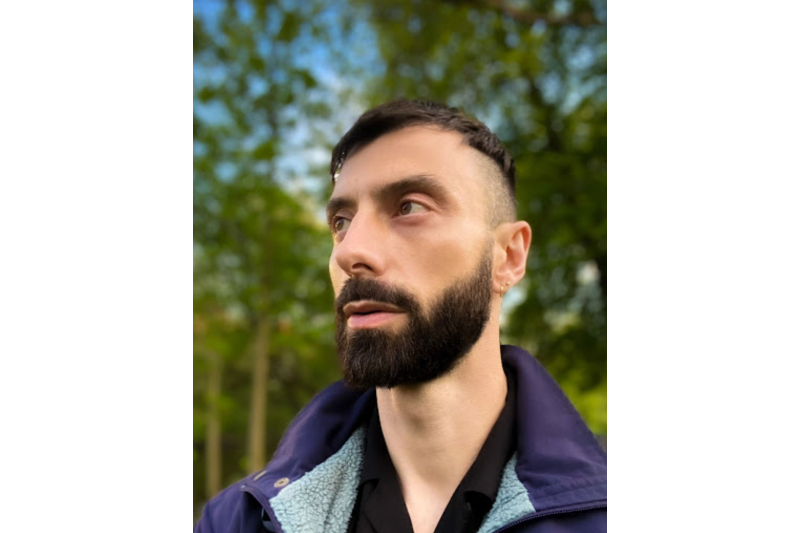Marco Torrice is a Brussels-based dancer, teacher and choreographer originally from Rome. He has graduated at P.A.R.T.S. (Performing Arts Research and Training Studios) and has been involved in many different projects and companies while also teaching and giving workshops in different dance schools such as P.A.R.T.S. (Performing Arts Research and Training Studios), the Budapest Contemporary Dance Academy, SEAD (Salzburg Experimental Academy of Dance), Tanzfabrik (Berlin), Isadora Duncan Center (Prague), Artesis Plantijn Hogeschool (Antwerpen), ISAC | Institut Supérieur des Arts et Chorégraphies and at Da.Re. Dance Research (Rome). His latest project « Melting Pot » has taken him to undertake research, residencies and workshops to many cities in and outside of Europe. From Brussels to Brazil, Budapest, Rome and last time back around again in Belgium at the VIERNULVIER, spin-off presentation location to the Vooruit in Ghent.
Before coming to Brussels, you started off studying philosophy in Rome and you started taking your first dance classes. How old were you then, 19?
No…23 ! Which is pretty late for academic training. But I was already an autodidact, as a child, I was always dancing. It was a way of getting into a group of kids where otherwise I would have maybe been discriminated against because I was the little “gay-weirdo” one. Dancing was a way of finding my place.
I was studying philosophy but I also had this urge to do something with my body, to move and take care of it. Yet back then, the idea of becoming a professional dancer somehow felt a bit awkward to me because in Italy dancing was always closely associated with TV shows and video clips and that I just didn’t like any of that.
What I found cool instead was contemporary dance. I would take classes twice a week and very quickly, everybody was telling me how great I was and that I should go for it. It made me wonder how come I didn’t think of it before. I had realized how much I loved dancing and I was actually great at it. So I did an audition at P.A.R.T.S and that’s how it all started.
So what can you tell me about your project “Melting” Pot?
It started in 2017, at first I had this little frustration with the socio-cultural environment of contemporary dance, simply because I found that it wasn’t really representing me or the people around me. I wanted something that was about dancing with people and not so much about being watched. I took part at this residency in Brazil where I opened up my dance research to all kinds of dancers, actors, krumpers, voguers, ballerinas, etc. My idea was to create an improvisation dance course to facilitate exchanges between different dance styles.
When I came back here, I applied for funding at the VGC to keep the project going. The project always took place in the form of a jam session, not so much of a choreography. People would come and go, and many would stay for multiple sessions. But then at some point, I’ve felt the urge to make it evolve into something more, add some choreography around the improvisation. It took me some time as I’m bit of a slow artist, I’m not constantly or consistently producing dance pieces. First I wanted it to be a practice, like an on-going thing. It’s around last year that I decided to create a choreography and work with a fixed group of dancers and turn it into a piece.
The movement material is still produced by improvisation, so you move freely yet you still respect the “rules” that structure the piece. So they know what comes first, what comes next, it is going to be a subtle transition or a sharp change? What’s great is that then we can play with the different styles, bodies and levels of dance-expertise but still communicate within the set of different rules.
Was there a specific moment when you decided to go to Brussels and fully to dancing?
Well the workshop I was following was way too expensive for me but then I did hear that those teachers and styles I was interested in were also to be found at P.A.R.T.S. I decided to give it a try because it felt like the right place for me. So I went for it and it’s actually the only edition I did ever. At first, it was a lot of proprioception and somatic work without it being super dynamic, it was a more technical and anatomical study approach.
You have a very impressive resume, did you know you would get this far or were there any times when you doubted you’d make it?
I didn’t know, even when I started at P.A.R.T.S., of course I had ups and downs when it comes to believing in myself and having motivation but what pushed me was the thought of : “No matter what happens or where I end up, I just know that I love dancing so much and I have to go for it. I didn’t really have a choice, it was like a calling. I just had to do it. Maybe I’ll work for the rest of my life in restaurants but I want to dance and I’ll find my way.”
How do you feel when you’re dancing, what does it do for you?
I’d say it’s certainly the connection with people, through sound and rhythm. It’s a sort of cathartic experience. It’s letting go of accumulated tension. Because of my background, I always have an abstract and physical approach. It’s never really so much about inner state or emotions but somehow they just come up through physicality. It’s like I have this mechanical task and then I sort of trip on the movement and that’s when emotions flow through.
Is there any difference for you between dancing as a performer and dancing at a party?
Lately, I’ve been dancing less and less. When I’m doing Melting Pot, I’m mostly standing on the side. When I dance for other projects, it’s not so “dancy”. My strongest experience of dance has been related to parties. At a performance, people are there to watch you, while at a party people are there to dance with you. That is exactly what Melting Pot is trying to do : combine these two functions. I would also say that lately I’m not much into being looked at. The more I go out, I feel like dancing is a great social tool, it’s made to share.
You’ve also directed your creative research towards the social aspect, could you tell me more about it?
Dance can not only be something to be watched but it’s also something you share by doing it. It has a performative and a social aspect, when you dance with people it’s a way to connect. It’s the same as for language. It can be used in a theatralic-performative way where there’s a group of people sitting and listening to you speaking – or – language can be a social tool, you’re in a group of people and we talk together and listen. When we dance, I look at you, I dance and you answer to me and it’s more like a conversation.
What was the first intention you felt that made you want to make Melting Pot turn out the way it has now?
I think I wanted to immortalize something. I spent so much time and energy, so much joy and so many great experiences that I wanted to make a point. To say that after all these years I wanted to make something that I can see and say “This is it.” Of course it’s a bit tricky because it’s just one version because there’s both the Melting Pot dance practice and the Melting Pot dance performance. At first it was just about dancing with people, then I wanted people to look at it.
So what are your plans for the future?
I want to start with a new research project which I won’t tell anything about yet. But what I also want to do is work further with two of the dancers from Melting Pot :
Mavi Veloso – a trans woman and multidisciplinary artist that also does singing and performance. I would love to support her work because it opens up so many themes that are so urgent to me – that really touched me. I want to use my knowledge to push the work of someone else, for example I would love to enstage a concert for her.
Also, Luiz Felipe with who we started Melting Pot in Brazil : He’s an actor and has starred in a Netflix series, he’s doing a long residency with two amazing music producers from Sao Paulo, they do this brazilian funk from the 90s with a contemporary feeling while he adds “putarias” (dirty lyrics) and I’m going to join them in Zaragoza, meet and talk with them all and see what’s going to happen.
Sounds like you’re ready for mentoring?
I just want to serve others’ art with my expertise, maybe mentoring is indeed a nice word for it. I feel very lucky to be working with these people. For me it’s the moment where art becomes this irresistible thing, where you do it because you feel you have to do it.
You may also like
-

The Bloemardin: Brussels’ Forgotten Rebel Spirit
If you’ve ever wandered past Brussels City Hall, you might have noticed a small statue
-

Identities in Motion: Justine Theizen’s POV Brings Hip Hop, Humor, and Queer Stories to the Stage
POV, the new creation by choreographer and performer Justine Theizen, blurs the boundaries between hip hop,
-

Rob Jetten, Openly Gay Centrist Leader, Poised to Become the Netherlands’ Youngest Prime
At 38, Rob Jetten stands on the verge of making history as both the youngest
-

Roddy Bottum’s “The Royal We”: A Memoir of Excess, Art, and Survival
In The Royal We, Faith No More keyboardist Roddy Bottum opens a window into a vanished
-

“Beautiful Things & Confident Mystique: Benson Boone, Pop’s Electrifying Enigma”
Benson Boone, born in 2002 in Monroe, Washington, has quickly become one of the most

